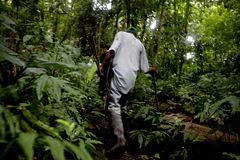In 1996 and 1997, several mass displacements took place in the Lower Atrato1 when paramilitary groups -with the alleged participation of the Colombian national army2- carried out counter-insurgency manoeuvres in the region.3 These operations, known as "Operation Genesis" or "Black December" left a trail of death, disappearances, destruction, burnt property, and thousands of people forcibly displaced.4 In just Curbaradó and Jiguamiandó, approximately 3,000 Afro-descendent and mixed-raced people were forcibly displaced. For many years, most of the inhabitants lived in situations of displacement in shelters or with family members in other regions of Antioquia and Chocó.5 In 1999, the displaced families began to return to Jiguamiandó,6 and in 2006 to Curbaradó,7 even though the armed conflict has continued in the region.8
Since then the returned population has confronted pressure exerted by illegal armed actors. For instance, paramilitary groups -resorting to a strategy of collective punishment and submission to force the communities to leave their territories9- subjected the communities along the Jiguamiandó River to an indiscriminate internment for several months in 2003.10
The Colombian Human Rights Ombudsman's Office has closely followed this matter in the Curbaradó and Jiguamiandó River Basins. On 31 December 2009, the Ombudsman's Office issued Risk Report No. 031, which determined that the inhabitants of the Humanitarian Zones and Biodiversity Zones of Jiguamiandó and Curbaradó faced a situation of risk due to the presence of illegal armed actors in the collective territory, ineffective legal protection, and undue intervention by individuals and companies into the internal matters of the community councils.11 Furthermore, on 23 March 2011, the Ombudsman's Office issued a follow-up brief to the Risk Report, which stated that the "Black Eagles or Urabeños" illegal armed groups and the Revolutionary Armed Forces of Colombia (FARC) were present in the collective territories of the area.12
1 Displacements were recorded in the Cacarica, Salaquí, Curvaradó, Vigía de Curbaradó, Domingodó, Jiguamiandó, and Riosucio River Basins, among others. More than 50 communities were displaced in the region of the Lower Atrato. Most of the people went to Turbo and Pavarandó (Antioquia) or Riosucio (Chocó). Some communities also crossed the Darién towards the border with Panamá. "Un llamado por el Chocó"
2 According to Freddy Rendón Herrera, aka ‘El Alemán', former paramilitary chief of the Élmer Cárdenas Block, the regional paramilitary structure known as the Peasant Self-Defence Forces of Córdoba and Urabá (ACCU) provided troops, while State security forces made sure "not to obstruct the ACCU's expansion in the areas where Operation Genesis was being carried out". "¿Quién mató a Argentino?", El Espectador, 24 January 2010; "La complicidad entre militares y paras en el Urabá Antioqueño", Verdad Abierta, 26 April 2011
3 "El ‘dossier' de los palmeros", El Espectador, 26 January 2008
4 Operation Genesis forcibly displaced 10,000 small-scale farmers. "Operación Génesis: exigiendo justicia", PBI Colombia, October 2009
5 "La Tramoya - Derechos Humanos y Palma Aceitera - Curvaradó y Jiguamiandó", CIJP and CINEP Database, 25 January 2006
6 "Informe sobre la visita al terreno en relación con las medidas provisionales ordenadas a favor de los miembros de las comunidades constituidas por el Consejo Comunitario de Jiguamiandó y las familias del Curbaradó, municipio del Carmen del Darién, departamento del Chocó, República de Colombia", Inter-American Commission on Human Rights, 20 February 2009.
7 Interviews with inhabitants from the Humanitarian Zones in Curbaradó, PBI Colombia, November 2010
8 In 2000, paramilitary incursions forced the population to flee into the jungle. On 12 September 2001, the Puerto Lleras and Pueblo Nuevo massacres occurred in the Jiguamiandó River Basin, which caused new mass displacements of the population.
9 "Confinamiento de población civil: Una aproximación conceptual para la caracterización de este fenómeno en Colombia", Consultancy for Human Rights and Displacement (CODHES), 28 June 2005
10 Definition of confinement: This entails the situation of violations to rights and freedoms -including restrictions to the freedom of movement and access to indispensable means of survival- committed against the civilian population as a result of explicit or implicit practices of military, economic, political, cultural, social or environmental control employed by legal or illegal armed groups within the framework of the armed conflict. "Comunidades confinadas en Colombia", PCS, 29 November 2004
11 Order 448 of 18 May 2010, Constitutional Court
12 "Nota de Seguimiento N°005-01 Primera al Informe de Riesgo N° 031-09 A.I.", Human Rights Ombudsman's Office on Risk Evaluation of the Civilian Population as a result of the Armed Conflict, Early Warning System, 23 March 2011

